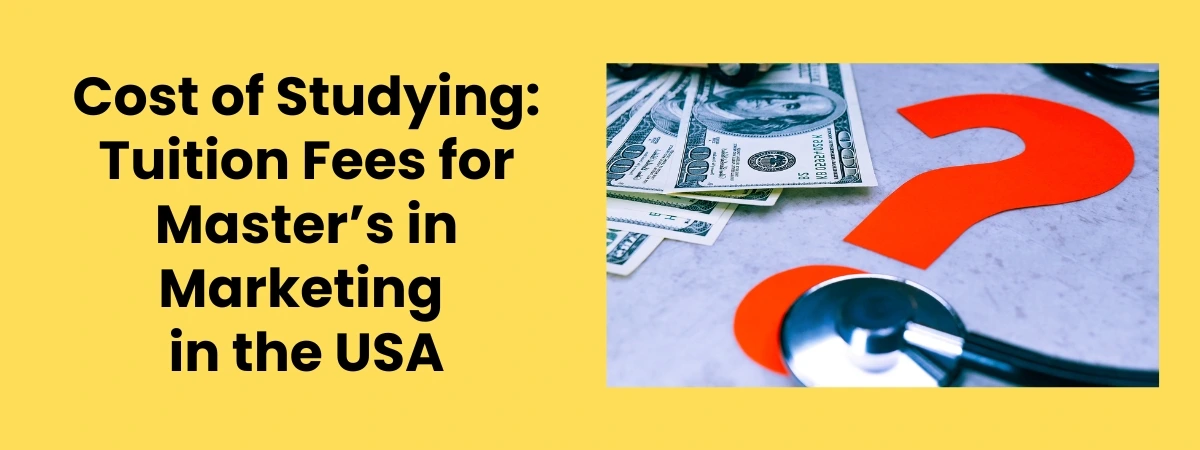A Master’s in Marketing is a graduate degree that teaches advanced skills in areas like digital marketing, brand management, and consumer behavior. The USA is one of the best places to study marketing because of its top-ranked universities, diverse programs, and strong connections to the industry. A degree from a US university can open doors to high-paying jobs and a successful career in marketing. This guide provides an in-depth look at the various aspects of pursuing a Masters in Marketing in USA, including program structure, admission requirements, career prospects, and more.
Key Facts
- Marketing industry revenue in the USA: $497 billion
- Job growth for marketing professionals: 10% from 2022 to 2032 (U.S. Bureau of Labor Statistics – BLS)
- Number of international students in the USA: Over 1 million in 2023 (Institute of International Education – IIE)
- Average salary of marketing professionals in the USA: $98,000 per year)
Why Study a Masters in Marketing in USA
Here are some key reasons to study marketing in the USA:
- Globally Recognized Universities: 8 out of the top 50 business schools worldwide are in the USA. Employers around the world value the skills and knowledge gained from US programs.
- High Job Opportunities: The U.S. has 2.1 million marketing jobs.
- Practical Learning: 85% of marketing programs include internships or live projects.
- Various Specializations: Options include Digital Marketing, Brand Management, and Market Analytics.
- Digital Marketing: Learn about online advertising, social media, and SEO.
- Brand Management: Focus on building and managing brands.
- Consumer Behavior: Study how people make buying decisions.
- Marketing Analytics: Use data to make better marketing decisions.
- Networking Benefits: 73% of students get job offers through alumni or industry connections.
Which Are the Top Universities/Colleges for a Masters in Marketing in USA?
Here’s a list of top universities/colleges offering Master’s in Marketing programs along with their rankings, tuition fees, and average salary outcomes:
- Kellogg School of Management (Northwestern University)
- McCombs School of Business (University of Texas at Austin)
- Gies College of Business (University of Illinois Urbana-Champaign)
- Columbia Business School
- University of Illinois Chicago (UIC) College of Business
- Johns Hopkins Carey Business School
- NYU Stern School of Business (New York University)
- Smith School of Business (University of Maryland)
- USC Marshall School of Business (University of Southern California)
- Florida International Univesity (FIU) Business
- D’Amore-McKim School of Business (Northeastern)
Also Read: Masters in Artificial Intelligence in USA

Can I Pursue a Masters in Marketing in USA Without GMAT/GRE?
Yes, it is absolutely possible to pursue a Master’s in Marketing in the USA without GMAT or GRE scores. Many universities offer test-optional policies or waivers based on work experience, GPA, or other qualifications. However, it’s important to research programs carefully and ensure you meet all other admission requirements.
- GMAT/GRE Required: Some top-tier universities, like Kellogg School of Management (Northwestern University) and Columbia Business School, still require GMAT or GRE scores.
- GMAT/GRE Optional: Many universities, such as University of Illinois Urbana-Champaign and University of Florida, allow applicants to apply without GMAT/GRE scores if they meet certain criteria (e.g., work experience, high GPA).
- No GMAT/GRE Required: Some universities, like Southern New Hampshire University (SNHU) and DePaul University, do not require GMAT/GRE scores at all.
Top Universities Offering Master’s in Marketing Without GMAT
Here’s a list of universities that either do not require GMAT/GRE or offer waivers based on work experience or GPA:
| University | Program Name | GMAT Requirement |
| New York University (NYU) | MS in Integrated Marketing | Not Required |
| University of Illinois Urbana-Champaign | MS in Strategic Brand Communication | Optional |
| University of Florida | MS in Marketing | Optional |
| University of Southern California (USC) | MS in Marketing | GMAT Waiver Available |
| Southern New Hampshire University (SNHU) | MS in Marketing | Not Required |
| DePaul University | MS in Marketing | Not Required |
| Loyola University Chicago | MS in Marketing | No GMAT Required |
| Northeastern University | MS in Digital Marketing | No GMAT |
| University of Denver | MS in Marketing | Optional |
| University of Maryland Global Campus | MS in Marketing | Not Required |
Also Read: Engineering Management Courses in USA
What Are the Admission Requirements?
Every university has different admission criteria, but the general requirements for Masters in Marketing in USA include:
| Requirement | Details |
| Bachelor’s Degree | A 4-year undergraduate degree in any field. |
| GMAT/GRE Scores | Some universities require GMAT (600-700) or GRE (310+). |
| English Proficiency | IELTS: (6.5-7.0)TOEFL: (90-100) |
| Statement of Purpose (SOP) | An essay about career goals and motivation. |
| Letters of Recommendation (LORs) | Usually 2-3 letters from professors or employers. |
| Resume/CV | Detailing academic background, work experience, and skills. |
| Work Experience | Preferred but not mandatory at most universities. |

Cost of Studying: Tuition Fees for Master’s in Marketing in the USA
The tuition fees for a Masters in Marketing in USA vary depending on the university, program structure, and location. On average, tuition costs range between $30,000 – $90,000 per year.
Estimated Tuition Fees Ranges
| Type of Institution | Estimated Annual Tuition Fees |
| Public Universities | $30,000 – $50,000 |
| Private Universities | $50,000 – $90,000 |
| Top Business Schools | $70,000 – $90,000 |
Additional Costs to Consider:
- Living Expenses: $12,000 – $20,000 per year (varies by city).
- Books & Supplies: $1,500 – $3,000 per year.
- Health Insurance: $1,500 – $3,000 per year.
- Miscellaneous Expenses: $2,000 – $5,000 per year
Can International Students Work in the USA After Graduation?
Yes! The USA allows international students to work during and after their studies through OPT (Optional Practical Training) and H-1B visas.
| Work Option | Details |
| Part-Time Work | Students can work 20 hours/week during semesters and 40 hours/week during breaks. |
| OPT (Optional Practical Training) | Allows students to work for 12 months after graduation. |
| STEM OPT Extension | Some marketing analytics programs qualify for a 24-month extension, allowing up to 36 months of work in the USA. |
| H-1B Visa | Graduates can apply for an employer-sponsored work visa to stay in the USA. |
What Are the Job Placement Rates for Marketing Graduates in USA?
Job placement rates for marketing graduates from top universities in the USA are generally high. Below is a table illustrating the placement rates and average starting salaries for graduates from some of the top universities:
| University | Placement Rate (%) | Average Starting Salary ($) |
| Harvard University | 88.45 | 71,715.43 |
| Stanford University | 98.23 | 80,957.53 |
| MIT | 92.34 | 103,810.18 |
| University of Pennsylvania | 85.10 | 96,833.54 |
| Columbia University | 92.52 | 92,422.72 |
Scholarships and Financial Aid for International Students
Several scholarships are available for international students pursuing a Master’s in Marketing in the USA. Some of the most popular scholarship programs include:
- FIU Online Academic Merit Scholarship
- Purdue Master’s Scholarship
- Partial Tuition Fellowship
- Dean’s Alumni Advisory Board (DAAB) Scholarships
- AAUW International Fellowship
- Graduate School Fellowship
- USC Libraries Research Reward
- SGA Residential Scholarship
These scholarships can help offset the cost of tuition and make education more affordable for international students.
Also Read: Duolingo Accepting Universities in USA
What Jobs Can You Get After a Master’s in Marketing?

Graduates have many career options in industries like technology, finance, healthcare, and e-commerce.
| Job Role | Average Salary (per year) |
| Marketing Manager | $98,000 |
| Digital Marketing Specialist | $75,000 |
| Brand Manager | $110,000 |
| Market Research Analyst | $71,000 |
| Social Media Manager | $65,000 |
| Product Marketing Manager | $120,000 |
| Chief Marketing Officer (CMO) | $180,000+ |
What Does the Course Structure Look Like?
A typical Master’s in Marketing program in the USA takes 1-2 years to complete and includes 30-45 credit hours. The curriculum consists of core subjects, electives, and a final project or internship.
Core Subjects
- Marketing Analytics
- Consumer Behavior
- Digital & Social Media Marketing
- Brand Management
- Market Research
- Business Ethics & Marketing Law
ELECTIVES
- SEO & SEM
- Global Marketing
- E-commerce Marketing
- Content Marketing
- Product Marketing
Internship & Capstone Project
Most programs offer an internship component, allowing students to gain hands-on experience in real-world marketing roles. Additionally, a capstone project enables students to apply their knowledge to solve a real business challenge or conduct an in-depth marketing research study.

What Subjects Will You Study in a Master’s in Marketing Program in the USA?
A Master’s in Marketing program in the USA is designed to provide students with a strong foundation in marketing principles while also offering specialized knowledge in areas like digital marketing, analytics, and consumer behavior. Each marketing program has a slightly different focus, but here are some common subjects you’ll encounter:
Core Subjects in a Master’s in Marketing Program
These are the foundational courses that every marketing student must take. They provide the essential knowledge and skills needed to succeed in the field.
| Subjects | Description |
| Consumer Behavior | Learn how consumers make decisions and what influences their buying behavior. This course covers psychological, social, and cultural factors that impact purchasing decisions. |
| Marketing Research | Understand how to collect, analyze, and interpret data to make informed marketing decisions. Topics include survey design, data analysis tools, and market segmentation. |
| Strategic Marketing | Focus on developing marketing strategies that align with business goals. Learn about competitive analysis, positioning, and long-term planning. |
| Marketing Analytics | Use data to measure the effectiveness of marketing campaigns. This course covers tools like Google Analytics, Tableau, and Excel for data visualization and interpretation. |
| Brand Management | Study how to create, maintain, and grow a brand. Topics include brand equity, brand positioning, and brand communication strategies. |
| Digital Marketing | Explore the world of online marketing, including SEO, social media marketing, email marketing, and pay-per-click (PPC) advertising. |
| Marketing Communications | Learn how to create effective communication strategies for advertising, public relations, and promotions. This course covers both traditional and digital channels. |
| Product Management | Understand the lifecycle of a product, from development to launch and beyond. Learn how to manage product portfolios and make data-driven decisions. |
What Elective Courses Can You Choose in a Master’s in Marketing Program?
Electives allow students to dive deeper into specific areas of interest. Here are some popular electives offered in US marketing programs:
| Subjects | Description |
| Social Media Marketing | Focus on content creation, engagement strategies, and analytics. |
| Search Engine Optimization (SEO) | Study how to optimize websites to rank higher on search engines like Google. Topics include keyword research, on-page SEO, and link-building strategies. |
| Data-Driven Marketing | Use big data and machine learning to predict consumer behavior and optimize marketing efforts. This course often includes hands-on experience with tools like Python and R. |
| Global Marketing | Explore how to market products and services in international markets. Learn about cultural differences, global branding, and cross-border marketing strategies. |
| Retail Marketing | Focus on marketing strategies for retail businesses. Topics include store layout, visual merchandising, and customer experience management. |
| E-Commerce Marketing | Explore strategies for marketing products and services online. Topics include website design, conversion rate optimization, and online payment systems. |
What Are the Internship Opportunities in a Master’s in Marketing Program in the USA?
Internships are a crucial part of a Master’s in Marketing program in the USA, offering hands-on experience, industry exposure, and networking opportunities. Many top universities have tie-ups with Fortune 500 companies, marketing agencies, and tech firms, providing students with valuable work experience.
Key Facts:
- 90% of marketing students complete at least one internship during their program.
- Internship duration: Typically 3-6 months, either paid or unpaid.
- Average stipend: $3,000 – $6,000 per month (varies by company & location).
- Top hiring companies: Google, Amazon, Apple, Procter & Gamble, and McKinsey
Top Internship Opportunities in Marketing
| Company | Internship Role | Duration | Average Stipend (USD) |
| Digital Marketing Intern | 12 weeks | $6,000/month | |
| Amazon | Brand Marketing Intern | 10-12 weeks | $5,500/month |
| Nike | Product Marketing Intern | 10 weeks | $4,500/month |
| Procter & Gamble (P&G) | Consumer Insights Intern | 12 weeks | $5,000/month |
| McKinsey & Co. | Marketing Strategy Intern | 10-12 weeks | $6,500/month |
| Meta (Facebook) | Social Media Marketing Intern | 12 weeks | $5,000/month |
| Adobe | Marketing Analytics Intern | 10 weeks | $5,500/month |
| Coca-Cola | Advertising & Promotions Intern | 12 weeks | $4,800/month |
How to Get a Marketing Internship in USA?
- University Career Centers: 80% of students secure internships through their university’s career support.
- Networking & LinkedIn: 70% of job seekers land opportunities via networking.
- Company Websites & Job Portals: Internships are regularly posted on Indeed, Glassdoor, and LinkedIn Jobs.
- Internship Programs: Many companies offer structured internship programs for master’s students.
Which is Better: MS in Marketing or MBA in Marketing?
Choosing between an MS in Marketing and an MBA in Marketing can be challenging, as both programs offer unique benefits. Your decision should depend on your career goals, background, and the skills you want to develop. Here’s a detailed comparison to help you decide which program is better for you.
What is an MS in Marketing?
An MS in Marketing (Master of Science in Marketing) is a specialized program focused entirely on marketing. It is ideal for students who want to dive deep into marketing concepts and gain technical expertise in areas like digital marketing, analytics, and consumer behavior.
Who Should Choose an MS in Marketing?
An MS in Marketing is a better choice if:
- You’re a Recent Graduate: If you’ve just completed your bachelor’s degree and want to specialize in marketing, an MS program is ideal.
- You Want Technical Skills: If you’re interested in areas like digital marketing, SEO, or marketing analytics, an MS program offers in-depth knowledge.
- You Have Limited Work Experience: Most MS programs are designed for students with 0-3 years of experience.
- You Want a Shorter Program: MS programs are typically shorter (10 months to 2 years) compared to MBA programs.
What is an MBA in Marketing?
An MBA in Marketing (Master of Business Administration with a Marketing concentration) is a broader business degree with a focus on marketing. It covers general business topics like finance, operations, and strategy, along with marketing-specific courses.
Who Should Choose an MS in Marketing?
An MS in Marketing is a better choice if:
- You’re a Recent Graduate: If you’ve just completed your bachelor’s degree and want to specialize in marketing, an MS program is ideal.
- You Want Technical Skills: If you’re interested in areas like digital marketing, SEO, or marketing analytics, an MS program offers in-depth knowledge.
- You Have Limited Work Experience: Most MS programs are designed for students with 0-3 years of experience.
- You Want a Shorter Program: MS programs are typically shorter (10 months to 2 years) compared to MBA programs.
Who Should Choose an MBA in Marketing?
An MBA in Marketing is a better choice if:
- You Have Work Experience: MBA programs prefer candidates with 3+ years of professional experience.
- You Want Leadership Roles: If you aim to become a Marketing Manager, Brand Director, or CMO, an MBA provides the leadership and management skills needed for these roles.
- You Want a Broader Skill Set: An MBA covers general business topics like finance, operations, and strategy, making it suitable for those who want a well-rounded education.
- You’re Willing to Invest More Time and Money: MBA programs are longer (2 years) and more
Cost Comparison: MS in Marketing vs. MBA in Marketing
| Progam | Average Tuition Fees | Duration | ROI (Return on Investment) |
| MS in Marketing | 30,000−70,000 | 10 months to 2 years | High for specialized roles |
| MBA in Marketing | 50,000−120,000 | 2 years | High for leadership roles |
Is MS in Marketing in the USA a STEM Program?
Yes, some universities in the USA offer MS in Marketing as a STEM-designated program, while others classify it under business studies. It depends on the curriculum and the university’s classification.
Why is STEM designation important for MS in Marketing?
- Longer Work Stay in the USA: Eligible for a 24-month OPT extension (total 3 years).
- Higher Employability: More focus on data-driven marketing and analytics skills.
- Better Salary Prospects: STEM graduates often earn higher salaries.
Which universities offer a STEM MS in Marketing in USA?
Here are some universities that offer STEM-designated MS in Marketing programs:
| University Name | Program Name |
| University of Southern California (USC) | MS in Marketing Analytics |
| University of Texas at Dallas | MS in Marketing |
| University of Maryland | MS in Marketing Analytics |
| University of Rochester | MS in Marketing Analytics |
| Northeastern University | MS in Digital Marketing & Data Analytics |
| Columbia University | MS in Marketing Science |
How to check if an MS in Marketing is STEM?
- Look for programs with names like “Marketing Analytics”, “Marketing Science”, or “Digital Marketing & Data Analytics.”
- Check the CIP code assigned to the program on the university’s website.
- Contact the admissions office to confirm the STEM status.
Conclusion
Pursuing a Masters in Marketing in USA offers numerous benefits, including access to world-class education, diverse specializations, and strong career prospects. However, it also comes with challenges such as intense competition, high costs, and cultural adjustment. Prospective students should carefully consider their goals, financial situation, and readiness to undertake a rigorous academic program. With the right preparation and mindset, a Master’s in Marketing from a US institution can be a transformative step towards a successful and fulfilling career in marketing.
FAQs
Can I Pursue a Masters in Marketing in USA Without a Business Background?
Yes, many universities in the USA accept students from non-business backgrounds for their Masters in Marketing programs. However, you may need to complete prerequisite courses in areas like economics, statistics, or marketing fundamentals. Some programs also offer bridge courses to help students from diverse academic backgrounds transition smoothly.
How Do I Choose Between a General Marketing Program and a Specialized Program (e.g., Digital Marketing, Data Analytics)?
Your choice depends on your career goals:
1. General Marketing Programs: Offer a well-rounded education and are ideal if you’re unsure about your specialization.
2. Specialized Programs: Focus on niche areas like digital marketing, data analytics, or brand management. These are better if you have a clear career path in mind.
Can I Switch Careers After Completing a Masters in Marketing in USA?
Yes, a Masters in Marketing can help you transition into marketing roles from unrelated fields. Many programs offer foundational courses to help you build the necessary skills. Additionally, internships and networking can facilitate the career switch.
What Are the Emerging Specializations in Marketing That I Should Consider?
Some trending specializations include:
1. Digital Marketing: SEO, social media, and content marketing.
2. Data Analytics: Using data to drive marketing decisions.
3. Sustainability Marketing: Promoting eco-friendly products and practices.
4. AI in Marketing: Leveraging AI for personalized marketing and automation
What Are the Common Mistakes to Avoid When Applying for a Masters in Marketing in the USA?
1. Ignoring Program Fit: Don’t apply to programs solely based on rankings; consider curriculum, faculty, and career support.
2. Weak SOP: A poorly written Statement of Purpose can hurt your application.
3. Neglecting Recommendations: Choose recommenders who know you well and can provide detailed insights.
4. Missing Deadlines: Submit your application well before the deadline to avoid last-minute issues.
How Do I Balance Academics, Internships, and Networking During My Masters Program?
1. Time Management: Create a schedule to allocate time for studies, internships, and networking events
2. Prioritize: Focus on high-impact activities like internships and building relationships with professors.
3. Use University Resources: Career centers, alumni networks, and student organizations can help you manage your time effectively.
Related Post
Masters in Interior Design in USA
Masters in Economics in USA
Masters in Digital Marketing in USA
Masters in Data Science in USA














